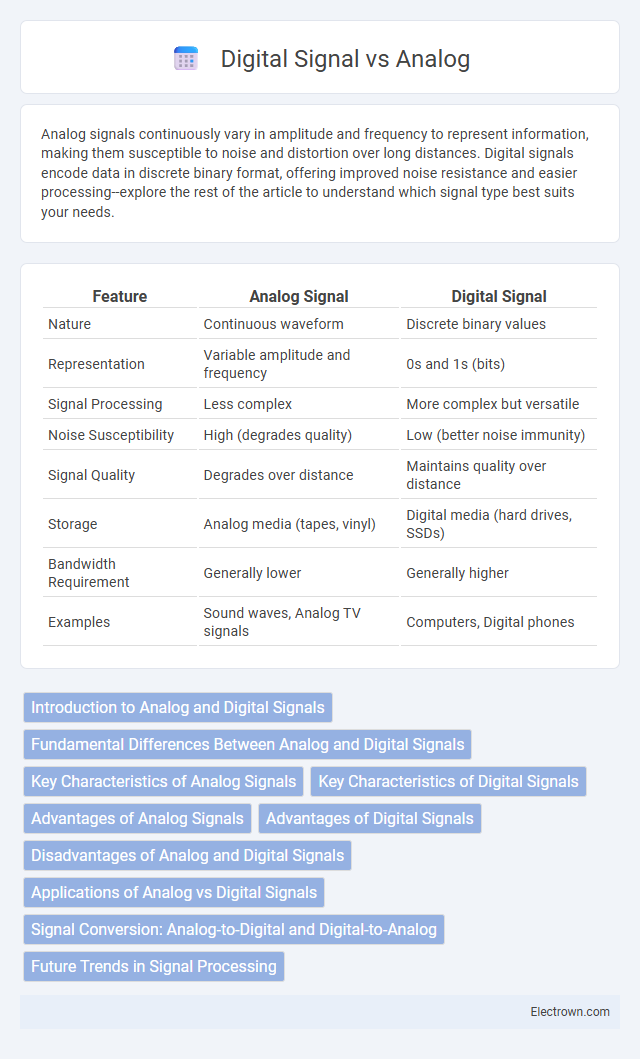Analog signals continuously vary in amplitude and frequency to represent information, making them susceptible to noise and distortion over long distances. Digital signals encode data in discrete binary format, offering improved noise resistance and easier processing--explore the rest of the article to understand which signal type best suits your needs.
Table of Comparison
| Feature | Analog Signal | Digital Signal |
|---|---|---|
| Nature | Continuous waveform | Discrete binary values |
| Representation | Variable amplitude and frequency | 0s and 1s (bits) |
| Signal Processing | Less complex | More complex but versatile |
| Noise Susceptibility | High (degrades quality) | Low (better noise immunity) |
| Signal Quality | Degrades over distance | Maintains quality over distance |
| Storage | Analog media (tapes, vinyl) | Digital media (hard drives, SSDs) |
| Bandwidth Requirement | Generally lower | Generally higher |
| Examples | Sound waves, Analog TV signals | Computers, Digital phones |
Introduction to Analog and Digital Signals
Analog signals vary continuously and represent information through fluctuations in voltage or current, making them ideal for capturing real-world phenomena like sound and light. Digital signals use discrete binary values, typically 0s and 1s, to process and store data with higher noise resistance and precision. Understanding the differences between analog and digital signals helps you choose the right approach for effective communication and data transmission systems.
Fundamental Differences Between Analog and Digital Signals
Analog signals vary continuously over time, representing information through fluctuating waveforms, while digital signals encode data as discrete binary values, typically in the form of 0s and 1s. Analog signals are susceptible to noise and distortion, which can degrade signal quality, whereas digital signals offer improved noise resistance and easier error detection and correction. The fundamental difference lies in analog's continuous waveform representation contrasted with the digital's discrete, quantized data format, influencing how information is processed and transmitted in communications and electronics.
Key Characteristics of Analog Signals
Analog signals exhibit continuous waveforms that vary smoothly over time, representing physical quantities like sound, light, or temperature. They can take any value within a given range, enabling high resolution but making them susceptible to noise and signal degradation. Common examples include audio signals captured by microphones and video signals from traditional television broadcasts.
Key Characteristics of Digital Signals
Digital signals are characterized by discrete values, typically represented as binary code with distinct voltage levels for zeros and ones. These signals exhibit robustness against noise and interference, enabling accurate data transmission over long distances. Furthermore, digital signals facilitate error detection and correction, supporting reliable communication in modern electronic systems.
Advantages of Analog Signals
Analog signals offer superior representation of continuous data, enabling smooth and natural sound or image reproduction without the quantization errors found in digital signals. Their simplicity in processing and transmission reduces the need for complex encoding or conversion equipment, making them cost-effective for certain applications. Analog signals also provide greater sensitivity to subtle variations, which is crucial in audio and sensor technologies where nuance is important.
Advantages of Digital Signals
Digital signals offer greater noise resistance and improved data integrity compared to analog signals, ensuring more reliable communication and better error detection. They enable easy compression and encryption, enhancing security and storage efficiency for multimedia content. Your systems benefit from compatibility with modern digital devices and simplified signal processing techniques.
Disadvantages of Analog and Digital Signals
Analog signals are prone to noise interference and signal degradation over long distances, leading to reduced quality and accuracy. Digital signals require complex encoding and decoding processes, which can introduce latency and increase system complexity. Both signal types face challenges in bandwidth efficiency and susceptibility to different types of distortion affecting overall performance.
Applications of Analog vs Digital Signals
Analog signals are commonly used in applications requiring continuous data representation, such as audio recording, radio broadcasting, and temperature sensing, where natural signal variations are essential. Digital signals dominate in computing, telecommunications, and digital media, offering improved noise resistance and data compression for efficient processing and transmission. You benefit from understanding these distinctions to choose the right signal type for your electronic or communication system design.
Signal Conversion: Analog-to-Digital and Digital-to-Analog
Analog-to-digital signal conversion involves sampling an analog waveform at regular intervals and quantizing the amplitude into discrete digital values, enabling accurate representation and processing by digital systems. Digital-to-analog conversion reconstructs the original analog signal from its digital representation using techniques like interpolation and filtering to smooth discrete data points into continuous waveforms. High-fidelity signal conversion relies on parameters such as sampling rate, bit depth, and quantization resolution to minimize distortion and preserve signal integrity in applications like audio, telecommunications, and instrumentation.
Future Trends in Signal Processing
Future trends in signal processing emphasize the integration of advanced digital techniques such as machine learning and AI to enhance adaptability and accuracy in data interpretation. Analog signal processing continues to play a crucial role in real-time, low-latency applications where signal fidelity is paramount. Your choice between analog and digital signals will increasingly depend on the specific demands of emerging technologies like IoT, 5G, and edge computing, highlighting the growing hybrid approach in signal processing systems.
Analog vs Digital Signal Infographic

 electrown.com
electrown.com